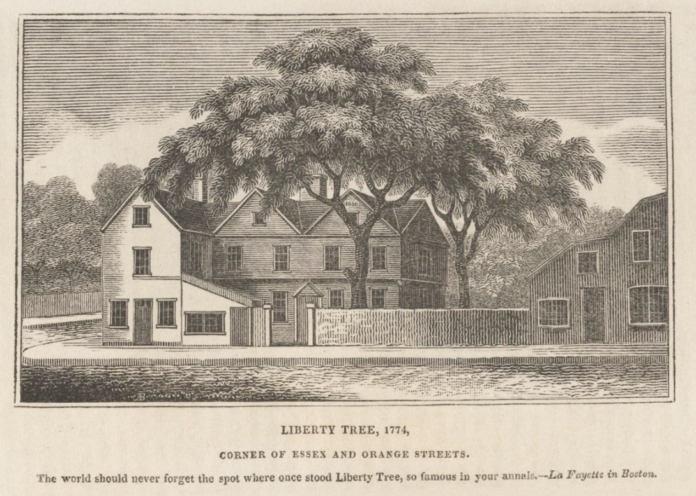The long path to the founding the United States of America did not begin with the signing of the Declaration of Independence in 1776, or the Shot Heard ‘Round the World at Lexington and Concord in 1775, or with throwing tea into the Boston Harbor in 1773. Instead, it began eight years earlier, under the limbs of a large elm tree that stood at the corner of what is now Essex and Washington Street, a block from Boston Common in Massachusetts. The 120-year-old tree would become known around the world as the Liberty Tree because under its canopy American colonists first defied the British Empire.
The relationship between the colonies and their mother country fundamentally changed in 1765 with the passage of the Stamp Act, British Parliament’s plan to pay for the recently-concluded French and Indian War. The law taxed all official documents circulating by colonists, whether they be merchants or newspapermen. While it wasn’t the first tax they had to pay — Americans already paid a tax on sugar exports to the old country — it was the first one to be directly assessed internally and without any consent of the governed in the form of political representation. The tax fell disproportionately on professionals, spurring the middle and upper classes into action.
“No taxation without representation” became the rallying cry of men like Sam Adams, who said the Stamp Act reduced colonists to mere slaves if they were not going to be given a voice in Parliament. “If our Trade be taxed, why not our Lands, or Produce in short, everything we possess?” he asked. “They tax us without having legal representation.”
Adams and other Boston radicals met secretly in a group called the Loyal Nine, a precursor to the Sons of Liberty, and planned their response. They recruited a man from the working class who had uncommon weight with the people to organize a protest rally.
The rally took place in the shade of what would be called the Liberty Tree, where they held a mock execution of the royal official responsible for administering the Stamp Act in Boston — the first public act of defiance against British rule. The ground around the tree became known as Liberty Hall and was a favorite place for protests and speeches denouncing British rule. When John Hancock’s ship was seized by a customs official, patriots stole his boat, dragged it up to Liberty Hall and burned it under the Liberty Tree. In 1770, the tree witnessed the funeral procession for the Boston Massacre victims.
In time, dozens or hundreds of trees were christened as “Liberty Trees” throughout the colonies as symbols of patriotism and centers for protests.
In time, dozens or hundreds of trees were christened as “Liberty Trees” throughout the colonies as symbols of patriotism and centers for protests, spreading as far as France and Italy.
Thomas Paine even wrote a poem about the venerable old elm tree.
But hear, O ye swains (’tis a tale most profane),
-Thomas Paine, Liberty Tree (1775)
How all the tyrannical powers,
Kings, Commons, and Lords, are uniting amain
To cut down this guardian of ours.
From the East to the West blow the trumpet to arms,
Thro’ the land let the sound of it flee :
Let the far and the near all unite with a cheer,
In defense of our Liberty Tree.
Knowing the original Liberty Tree was an important symbol to patriots, British troops and loyalists hacked it down and used it for firewood when they occupied Boston in 1775.
“The enemies of liberty and America,” reported the New England Chronicle, “repaired to a tree at the south end of Boston, known by the name of ‘Liberty Tree,’ and, armed with axes, etc. made a furious attack upon it. After a long spell of groaning, swearing, and foaming, with malice diabolical they cut down a tree because it bore the name of ‘Liberty’.”
After a long spell of groaning, swearing, and foaming, with malice diabolical they cut down a tree because it bore the name of ‘Liberty’.
New England Chronicle
However, the remaining stump continued to be a world-famous attraction, drawing the likes of the Revolutionary War hero Marquis de Lafayette when he returned to the Americas from France in 1825.
“The world should never forget the spot where once stood the Liberty Tree so famous in your annals,” he told a cheering crowd.
But by the 1960s, the Liberty Tree was all but forgotten, not even to be found on Boston’s Freedom Trail of historical Revolutionary War sites. Of the trees in other colonies that were inspired by the original, the last surviving one — a 400-year-old tulip poplar on the campus of St. John’s College in Maryland — was cut down in 1999 after being badly damaged by a hurricane.In 2018, the city of Boston completed a $1.3 million project to create a plaza at the original Liberty Tree location, now in Boston’s Chinatown, with areas for seating, a stone monument and a new elm tree to commemorate the place where Americans took their first step toward independence.


Pretty much how it is now..a plutocratic autocracy in a stew of crony capitalism. Ventura county manager makes as much as the US President..so absurd. But that’s Cali for you